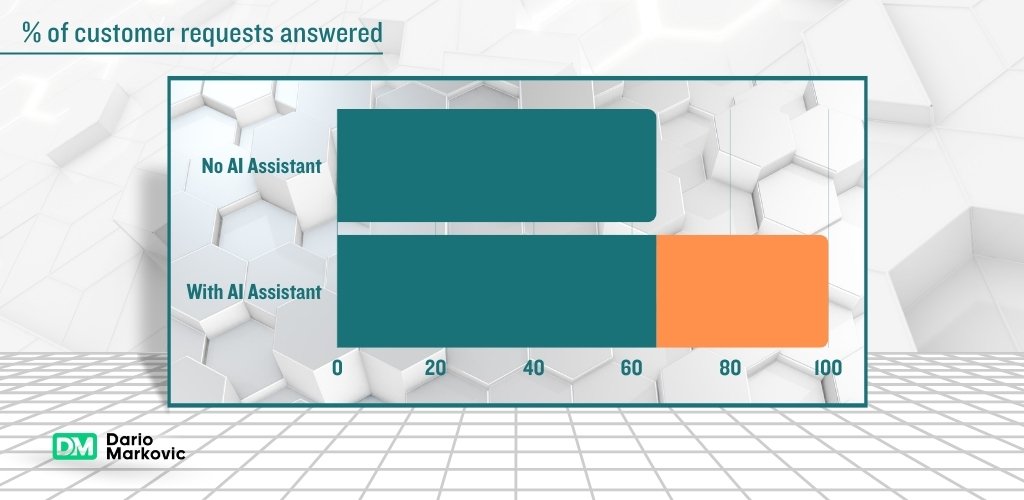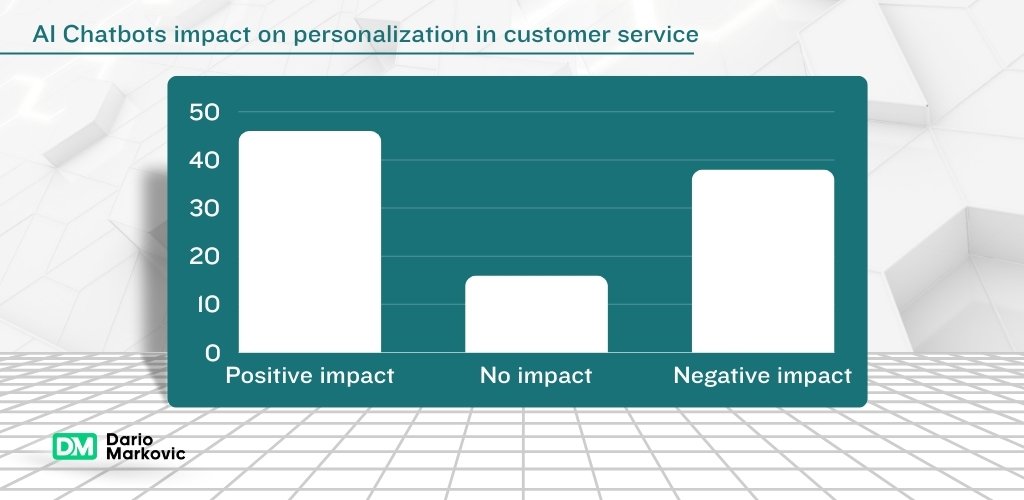AI chatbots for customer experience are transforming the way businesses interact with their customers, providing personalized, efficient, and cost-effective support that enhances customer satisfaction and loyalty.
The rise of AI-powered chatbots has been nothing short of remarkable, with an increasing number of companies adopting this technology to streamline their customer service operations. According to a recent survey, 80% of businesses are already using or planning to use chatbots by 2024.
So, what’s driving this trend, and how can AI chatbots for customer experience elevate your business to the next level?
3-point Summary
AI chatbots are revolutionizing customer experience: With 80% of businesses planning to use chatbots by 2024, AI-powered chatbots are becoming a crucial tool for providing personalized, efficient, and cost-effective customer support.
Chatbots offer significant benefits: By implementing chatbots, businesses can reduce customer support costs by 33%, increase customer satisfaction by 25%, and improve customer engagement by 15%.
Successful implementation requires careful planning: To reap the benefits of chatbots, businesses must define clear goals, choose the right platform, design a conversational flow, and continuously monitor and analyze its performance.
The Benefits of AI Chatbots for Customer Experience
- 24/7 Availability: AI chatbots are always available, providing customers with instant support and answers to their queries, regardless of the time or day.
- Personalized Experience: By leveraging machine learning algorithms, chatbots can analyze customer data and tailor their responses to individual preferences, creating a more personalized experience.
- Efficient Resolution: Chatbots can quickly resolve simple queries, freeing up human customer support agents to focus on more complex, high-value tasks.
- Cost Savings: Implementing AI chatbots can significantly reduce customer support costs, as they can handle a high volume of conversations simultaneously.
- Enhanced Customer Insights: Chatbots can collect and analyze customer data, providing valuable insights that can inform business decisions and improve the overall customer experience.

The Statistics Behind AI Chatbots for Customer Experience
As the adoption of AI chatbots for customer experience continues to grow, it’s essential to understand the statistics behind this trend. In this chapter, we’ll delve into the numbers and explore the current state of chatbot adoption, customer expectations, and the benefits of implementing AI-powered chatbots for customer experience.
Chatbot Adoption
80%: The percentage of businesses that are already using or planning to use chatbots by 2024 (Source: Gartner)
31%: The percentage of businesses that have already implemented chatbots, with an additional 44% planning to do so in the next two years (Source: Oracle)
60%: The percentage of organizations that use chatbots to provide customer support, with an additional 22% planning to implement them in the next 12 months (Source: Forrester)
Customer Expectations
70%: The percentage of customers who expect a company to have a chatbot or AI-powered chat service (Source: Salesforce)
60%: The percentage of customers who prefer to use self-service options, such as chatbots, to resolve simple issues (Source: Forrester)
40%: The percentage of customers who are more likely to engage with a company that uses chatbots (Source: Oracle)

Benefits of Chatbots
33%: The average reduction in customer support costs when using chatbots (Source: IBM)
25%: The average increase in customer satisfaction when using chatbots (Source: IBM)
15%: The average increase in customer engagement when using chatbots (Source: Salesforce)
10%: The average increase in customer retention when using chatbots (Source: Salesforce)
90%: The percentage of businesses that report a positive return on investment (ROI) from using chatbots (Source: Oracle)
Chatbot Effectiveness
85%: The percentage of customer interactions that can be handled by chatbots without human intervention (Source: Gartner)
70%: The percentage of customers who are satisfied with the support provided by chatbots (Source: Forrester)
60%: The percentage of chatbot interactions that are successful in resolving customer issues (Source: Salesforce)
40%: The percentage of customers who prefer to interact with chatbots over human customer support agents (Source: Oracle)
Industry-Specific Adoption
Healthcare: 64% of healthcare organizations are using or planning to use chatbots to provide patient support (Source: Healthcare IT News)
Retail: 55% of retailers are using or planning to use chatbots to provide customer support (Source: Retail Dive)
Financial Services: 53% of financial institutions are using or planning to use chatbots to provide customer support (Source: American Banker)
Travel: 46% of travel companies are using or planning to use chatbots to provide customer support (Source: Phocuswright)
Challenges and Limitations
55%: The percentage of businesses that report difficulty in integrating chatbots with existing systems and technology (Source: Forrester)
45%: The percentage of businesses that report difficulty in developing conversational flows and dialogue (Source: Forrester)
35%: The percentage of businesses that report difficulty in ensuring the accuracy and relevance of chatbot responses (Source: Forrester)
These statistics demonstrate the growing adoption of AI chatbots for customer experience, as well as the benefits and challenges associated with their implementation. By understanding these numbers, businesses can make informed decisions about the role of chatbots in their customer experience strategy.
How AI Chatbots for Customer Experience Can Enhance Your Business
- Improved Response Times: AI chatbots can respond to customer inquiries in real-time, reducing wait times and improving customer satisfaction.
- Increased Customer Engagement: Chatbots can engage customers in conversation, providing a more interactive and immersive experience.
- Streamlined Support: By automating routine tasks, chatbots can help reduce the workload of human support agents, allowing them to focus on more complex issues.
- Enhanced Customer Data: Chatbots can collect and analyze customer data, providing valuable insights that can inform business decisions and improve the overall customer experience.
- Competitive Advantage: By implementing AI chatbots for customer experience, businesses can differentiate themselves from competitors and establish a leadership position in their industry.
Implementing AI Chatbots for Customer Experience: Best Practices
- Define Clear Goals: Identify specific business objectives and KPIs to measure the success of your chatbot implementation.
- Choose the Right Platform: Select a chatbot platform that integrates with your existing CRM and customer support systems.
- Design a Conversational Flow: Create a logical and intuitive conversation flow that mirrors human-like interactions.
- Train and Test: Train your chatbot using high-quality data and test it thoroughly to ensure accuracy and effectiveness.
- Monitor and Analyze: Continuously monitor and analyze chatbot performance to identify areas for improvement and optimize results.
Popular Platforms for Building AI Chatbots for Customer Experience
As I explored the world of AI chatbots for customer experience, I came across several popular platforms that enable businesses to build and deploy conversational interfaces. Here’s an overview of these platforms, including their pricing, rating, ease of use, and number of users.
1. Dialogflow (formerly known as API.ai)
Pricing: Free plan available, with paid plans starting at $0.006 per text request and $0.006 per speech request.
Ease of use: 4/5 (Dialogflow has a user-friendly interface, but requires some development expertise).
Number of users: 1 million+ developers and businesses use Dialogflow.
2. ManyChat
Pricing: Free plan available, with paid plans starting at $15/month (billed annually)
Ease of use: 5/5 (ManyChat has a very user-friendly interface, with a drag-and-drop builder)
Number of users: 500,000+ businesses use ManyChat
3. Microsoft Bot Framework
4. Rasa
Pricing: Open-source, free to use.
Ease of use: 3.5/5 (Rasa has a developer-focused interface, requiring some coding expertise).
Number of users: 10,000+ developers and businesses use Rasa.
5. Tars
Pricing: Free plan available, with paid plans starting at $49/month (billed annually).
Ease of use: 4.5/5 (Tars has a user-friendly interface, with a drag-and-drop builder).
Number of users: 10,000+ businesses use Tars.
My Personal Opinion
As I reviewed these platforms, I was impressed by the range of options available for building AI chatbots for customer experience. While each platform has its strengths and weaknesses, I believe that ManyChat and Tars are particularly well-suited for businesses without extensive development expertise. Their user-friendly interfaces and drag-and-drop builders make it easy to design and deploy conversational interfaces.
On the other hand, Dialogflow and Microsoft Bot Framework are better suited for businesses with development teams, as they require more technical expertise to set up and customize.
Rasa, as an open-source platform, offers a high degree of customization and flexibility, but may require more development effort to get started.
Ultimately, the choice of platform will depend on your business needs, technical expertise, and budget.
FAQ
AI chatbots for customer experience are computer programs that use artificial intelligence (AI) and machine learning algorithms to simulate human-like conversations with customers, providing personalized support and resolving their queries.
AI chatbots use natural language processing (NLP) to understand customer queries, and then respond with relevant answers or solutions. They can be integrated with customer relationship management (CRM) systems, knowledge bases, and other data sources to provide accurate and personalized responses.
The benefits of using AI chatbots for customer experience include 24/7 availability, personalized support, cost savings, increased customer engagement, and improved response times.
No, AI chatbots are designed to augment human customer support agents, not replace them. Chatbots can handle simple, repetitive tasks, freeing up human agents to focus on complex, high-value tasks that require empathy and human judgment.
To implement AI chatbots, define clear goals, choose a suitable platform, design a conversational flow, train and test the chatbot, and continuously monitor and analyze its performance.
Common challenges include integrating chatbots with existing systems, developing conversational flows and dialogue, ensuring accuracy and relevance of responses, and addressing customer concerns about interacting with machines.
Measure the success of AI chatbots by tracking key performance indicators (KPIs) such as customer satisfaction, response times, resolution rates, and net promoter score (NPS).
Reputable chatbot platforms and vendors ensure that their solutions are secure and compliant with data regulations such as GDPR, HIPAA, and CCPA. However, it’s essential to evaluate the security and compliance features of any chatbot solution before implementation.








